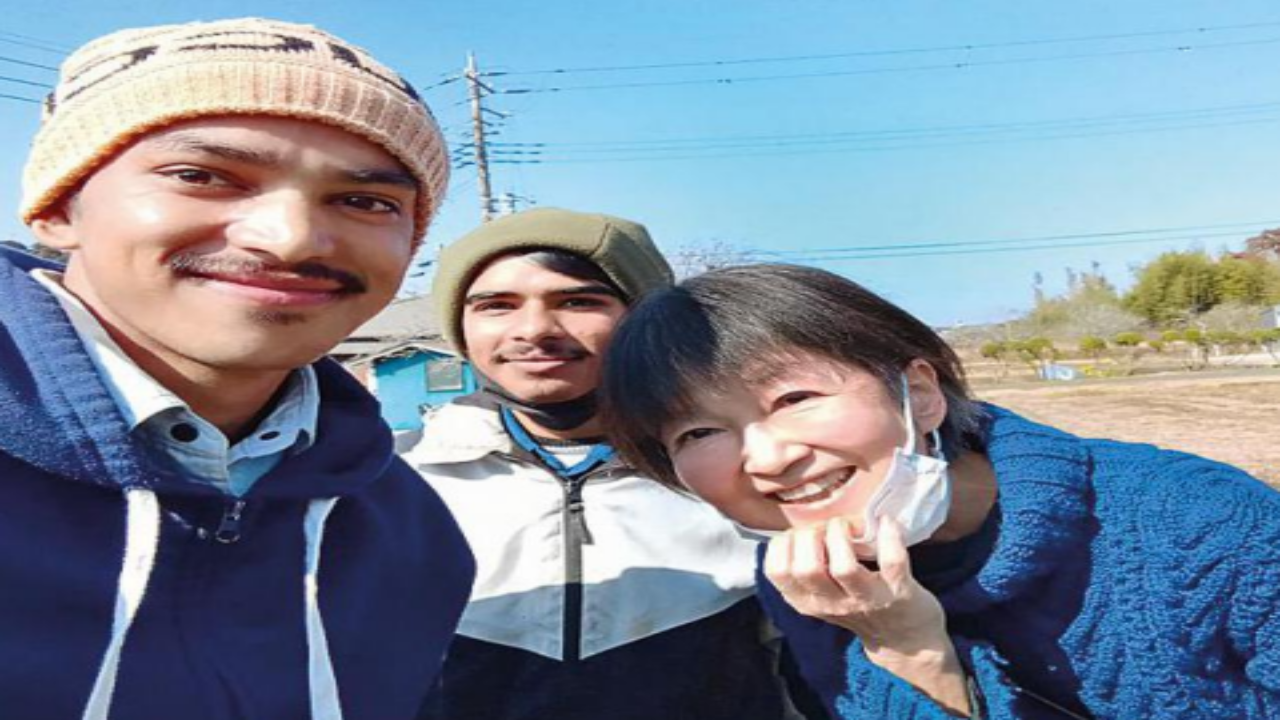[ad_1]
Nirmal Singh Ranswal, a class XII passout from Champawat, Uttarakhand, steps out on the field with a measuring tape. On this particular morning, he needs to sow cabbage; between every two saplings, he must leave a precise gap of 30cm. For, that is the sowing pattern followed in large swathes of Ichihara located in Chiba prefecture in Japan, where he is employed.
With over 20% of the country’s population being over 65, Japanese agriculturists are recruiting farm labour from across the Indian countryside. About 18 people, including Nirmal, were the first ones to leave in 2022; there are hundreds more queuing up to fly out in 2023. The workforce on these farms, which is predominantly Vietnamese and Chinese, does not comprise mere labourers. Skilled Indian labourers are also now among those heading to Japan, thanks to a Central government-run programme.
Monit Doley, 31, who has a PG diploma from East Siang, Arunachal, worked at a local restaurant and grew paddy on a small piece of land owned by the family for much of his life.
Japanese agriculturists are recruiting farm labour from across the Indian countryside. Monit Doley, 31 from Arunachal, worked at a local restaurant and grew paddy on a small piece of land. Now in his uniform, boots and gloves, he is in the middle of what is described as a “scientifically planned harvesting week” on a farm at Kawakami Mura in Nara. His routine begins at 3 am: they pluck vegetables early when there is natural moisture on the produce.
“While it is a fact that Japan needs young immigrants from around the world for various jobs, it is about getting the right people with the right skills. Not only do they need farmers, they need soil technicians, horse breeders,” said Kavi Luthra, MD of a consulting firm that works with the Maharashtra government and facilitates opportunities for local youth.
As per Central government records, until December 2022, 598 skilled immigrants left for Japan under a Technical Intern Training Program managed by the National Skill Development Corporation. Of these, 34 were hired from Maharashtra, said skills minister Mangal Prabhat Lodha. Agriculture is one of the sectors that Indian youth are eyeing.
The impact of Japan’s aging and shrinking population is visible in everything from its GDP and industrial output to the shape of its cities and public infrastructure. More than 20% of the population is over 65 years old, the highest proportion of elderly in the world. By 2030, the trend will accentuate and one in every three persons will be 65 or older, and one in five will be 75-plus.
“Japanese corporations want to recruit farmers, a class X or XII pass-out who has worked on farms or someone who has done a programme in agriculture or horticulture,” said Luthra. Apart from the salary which is largely repatriated home by the labourers, the company takes care of accommodation in dormitories that are plugged to WiFi and also provides insurance.
The contract is water-tight with clear norms for working hours and holidays, details of pay scales which range around 1.2 lakh yen (Rs 75,000) a month inclusive of labour tax, and with scope for overtime. Little wonder then that many daily wage workers on fields in India are signing up to send their children to Japan. Openings like a recent one advertised by a Japanese firm for picking Koyamaki (umbrella pines) sends Indian recruitment agencies into a frenzy; background research on the nature of work has to be thorough in order to recruit the right workforce. “The work is not about growing plants or vegetables, but about climbing up the mountain, cutting and collecting Koyamaki that is growing on the mountain and carrying them down from the mountain. However, it is a job that is also done by a 50-year-old Japanese,” says the Koyamaki ad. Many Indians are willing to find their Ikigai (life’s purpose) in a role like this, picking pines of coniferous evergreen trees to be used as an imperial crest for members of the Japanese Royal Family. Shiv Kumar from Palwal in Haryana and Satish Kumar Shrivastav from Baniganj are among those who took the flight out last year after learning a smattering of Japanese. The first week in Japan was “awkward to say the least”.
“After that, we have only seen the good bits of life here. Like, our company owner also works with us. No one is rude here. Even the smallest bits are planned and there is a lot of manuring they do to keep soil healthy,” said Shrivastav. Once Kumar got a call for being late by a minute after his lunch break. He switched to life per Japanese standard time after that incident. “I am never late to work, not even by a fraction of a second. I don’t know how I will survive by Indian standard time if I come back when my contract ends after three years.”
With over 20% of the country’s population being over 65, Japanese agriculturists are recruiting farm labour from across the Indian countryside. About 18 people, including Nirmal, were the first ones to leave in 2022; there are hundreds more queuing up to fly out in 2023. The workforce on these farms, which is predominantly Vietnamese and Chinese, does not comprise mere labourers. Skilled Indian labourers are also now among those heading to Japan, thanks to a Central government-run programme.
Monit Doley, 31, who has a PG diploma from East Siang, Arunachal, worked at a local restaurant and grew paddy on a small piece of land owned by the family for much of his life.
Japanese agriculturists are recruiting farm labour from across the Indian countryside. Monit Doley, 31 from Arunachal, worked at a local restaurant and grew paddy on a small piece of land. Now in his uniform, boots and gloves, he is in the middle of what is described as a “scientifically planned harvesting week” on a farm at Kawakami Mura in Nara. His routine begins at 3 am: they pluck vegetables early when there is natural moisture on the produce.
“While it is a fact that Japan needs young immigrants from around the world for various jobs, it is about getting the right people with the right skills. Not only do they need farmers, they need soil technicians, horse breeders,” said Kavi Luthra, MD of a consulting firm that works with the Maharashtra government and facilitates opportunities for local youth.
As per Central government records, until December 2022, 598 skilled immigrants left for Japan under a Technical Intern Training Program managed by the National Skill Development Corporation. Of these, 34 were hired from Maharashtra, said skills minister Mangal Prabhat Lodha. Agriculture is one of the sectors that Indian youth are eyeing.
The impact of Japan’s aging and shrinking population is visible in everything from its GDP and industrial output to the shape of its cities and public infrastructure. More than 20% of the population is over 65 years old, the highest proportion of elderly in the world. By 2030, the trend will accentuate and one in every three persons will be 65 or older, and one in five will be 75-plus.
“Japanese corporations want to recruit farmers, a class X or XII pass-out who has worked on farms or someone who has done a programme in agriculture or horticulture,” said Luthra. Apart from the salary which is largely repatriated home by the labourers, the company takes care of accommodation in dormitories that are plugged to WiFi and also provides insurance.
The contract is water-tight with clear norms for working hours and holidays, details of pay scales which range around 1.2 lakh yen (Rs 75,000) a month inclusive of labour tax, and with scope for overtime. Little wonder then that many daily wage workers on fields in India are signing up to send their children to Japan. Openings like a recent one advertised by a Japanese firm for picking Koyamaki (umbrella pines) sends Indian recruitment agencies into a frenzy; background research on the nature of work has to be thorough in order to recruit the right workforce. “The work is not about growing plants or vegetables, but about climbing up the mountain, cutting and collecting Koyamaki that is growing on the mountain and carrying them down from the mountain. However, it is a job that is also done by a 50-year-old Japanese,” says the Koyamaki ad. Many Indians are willing to find their Ikigai (life’s purpose) in a role like this, picking pines of coniferous evergreen trees to be used as an imperial crest for members of the Japanese Royal Family. Shiv Kumar from Palwal in Haryana and Satish Kumar Shrivastav from Baniganj are among those who took the flight out last year after learning a smattering of Japanese. The first week in Japan was “awkward to say the least”.
“After that, we have only seen the good bits of life here. Like, our company owner also works with us. No one is rude here. Even the smallest bits are planned and there is a lot of manuring they do to keep soil healthy,” said Shrivastav. Once Kumar got a call for being late by a minute after his lunch break. He switched to life per Japanese standard time after that incident. “I am never late to work, not even by a fraction of a second. I don’t know how I will survive by Indian standard time if I come back when my contract ends after three years.”
[ad_2]
Source link






Join The Discussion